Auditing and Assurance in Australia Report: CSL Pharmaceuticals Audit
VerifiedAdded on 2023/06/08
|20
|4037
|106
Report
AI Summary
This report presents an auditing and assurance analysis of CSL Pharmaceuticals, an ASX-listed company, focusing on the application of ASA 315. It begins with an executive summary and proceeds to conduct analytical procedures on the company's financial data for the last three years, including simple comparisons and ratio analysis, to identify unusual balances. The report then assesses the inherent risk at the financial report level, considering factors such as management integrity and industry conditions. Furthermore, it evaluates the inherent risk at the assertion level, selecting specific account balances and determining significant risks, followed by the identification of substantive audit procedures. The report concludes with a discussion of how analytical procedures influence audit planning decisions and the importance of internal control mechanisms in mitigating risks of material misstatement. This report aims to provide a comprehensive overview of auditing practices, risk assessment, and financial statement analysis in the context of a real-world case study.
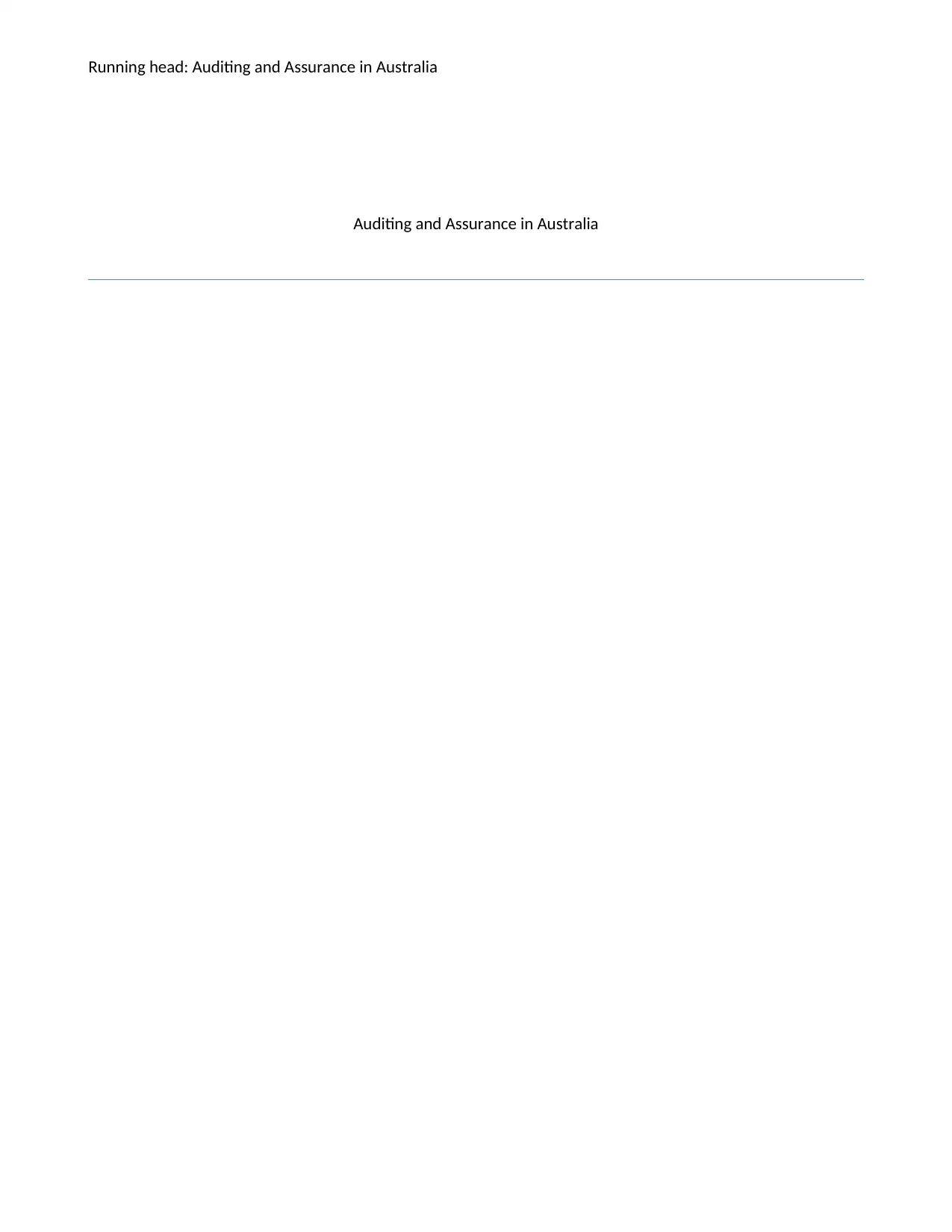
Running head: Auditing and Assurance in Australia
Auditing and Assurance in Australia
Auditing and Assurance in Australia
Paraphrase This Document
Need a fresh take? Get an instant paraphrase of this document with our AI Paraphraser
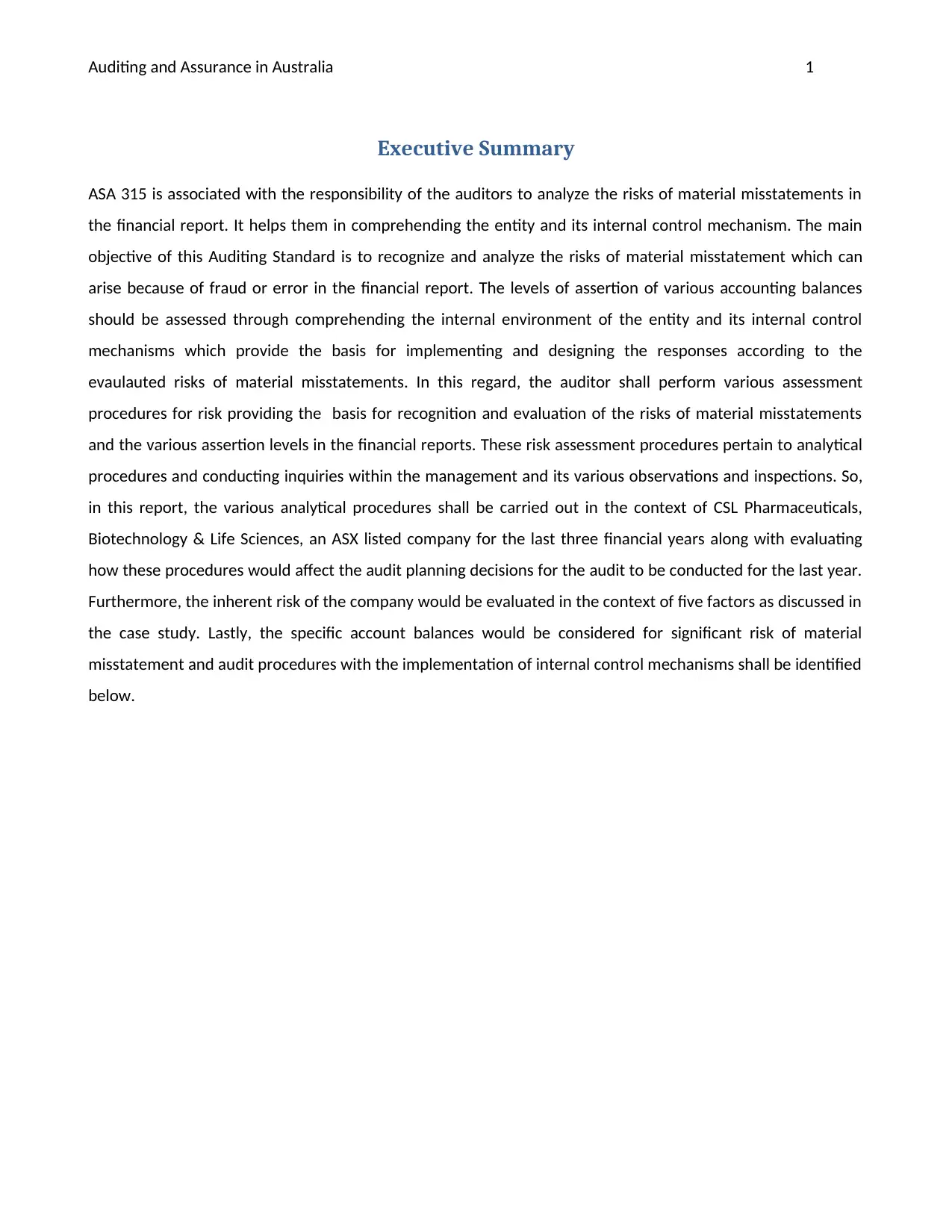
Auditing and Assurance in Australia 1
Executive Summary
ASA 315 is associated with the responsibility of the auditors to analyze the risks of material misstatements in
the financial report. It helps them in comprehending the entity and its internal control mechanism. The main
objective of this Auditing Standard is to recognize and analyze the risks of material misstatement which can
arise because of fraud or error in the financial report. The levels of assertion of various accounting balances
should be assessed through comprehending the internal environment of the entity and its internal control
mechanisms which provide the basis for implementing and designing the responses according to the
evaulauted risks of material misstatements. In this regard, the auditor shall perform various assessment
procedures for risk providing the basis for recognition and evaluation of the risks of material misstatements
and the various assertion levels in the financial reports. These risk assessment procedures pertain to analytical
procedures and conducting inquiries within the management and its various observations and inspections. So,
in this report, the various analytical procedures shall be carried out in the context of CSL Pharmaceuticals,
Biotechnology & Life Sciences, an ASX listed company for the last three financial years along with evaluating
how these procedures would affect the audit planning decisions for the audit to be conducted for the last year.
Furthermore, the inherent risk of the company would be evaluated in the context of five factors as discussed in
the case study. Lastly, the specific account balances would be considered for significant risk of material
misstatement and audit procedures with the implementation of internal control mechanisms shall be identified
below.
Executive Summary
ASA 315 is associated with the responsibility of the auditors to analyze the risks of material misstatements in
the financial report. It helps them in comprehending the entity and its internal control mechanism. The main
objective of this Auditing Standard is to recognize and analyze the risks of material misstatement which can
arise because of fraud or error in the financial report. The levels of assertion of various accounting balances
should be assessed through comprehending the internal environment of the entity and its internal control
mechanisms which provide the basis for implementing and designing the responses according to the
evaulauted risks of material misstatements. In this regard, the auditor shall perform various assessment
procedures for risk providing the basis for recognition and evaluation of the risks of material misstatements
and the various assertion levels in the financial reports. These risk assessment procedures pertain to analytical
procedures and conducting inquiries within the management and its various observations and inspections. So,
in this report, the various analytical procedures shall be carried out in the context of CSL Pharmaceuticals,
Biotechnology & Life Sciences, an ASX listed company for the last three financial years along with evaluating
how these procedures would affect the audit planning decisions for the audit to be conducted for the last year.
Furthermore, the inherent risk of the company would be evaluated in the context of five factors as discussed in
the case study. Lastly, the specific account balances would be considered for significant risk of material
misstatement and audit procedures with the implementation of internal control mechanisms shall be identified
below.
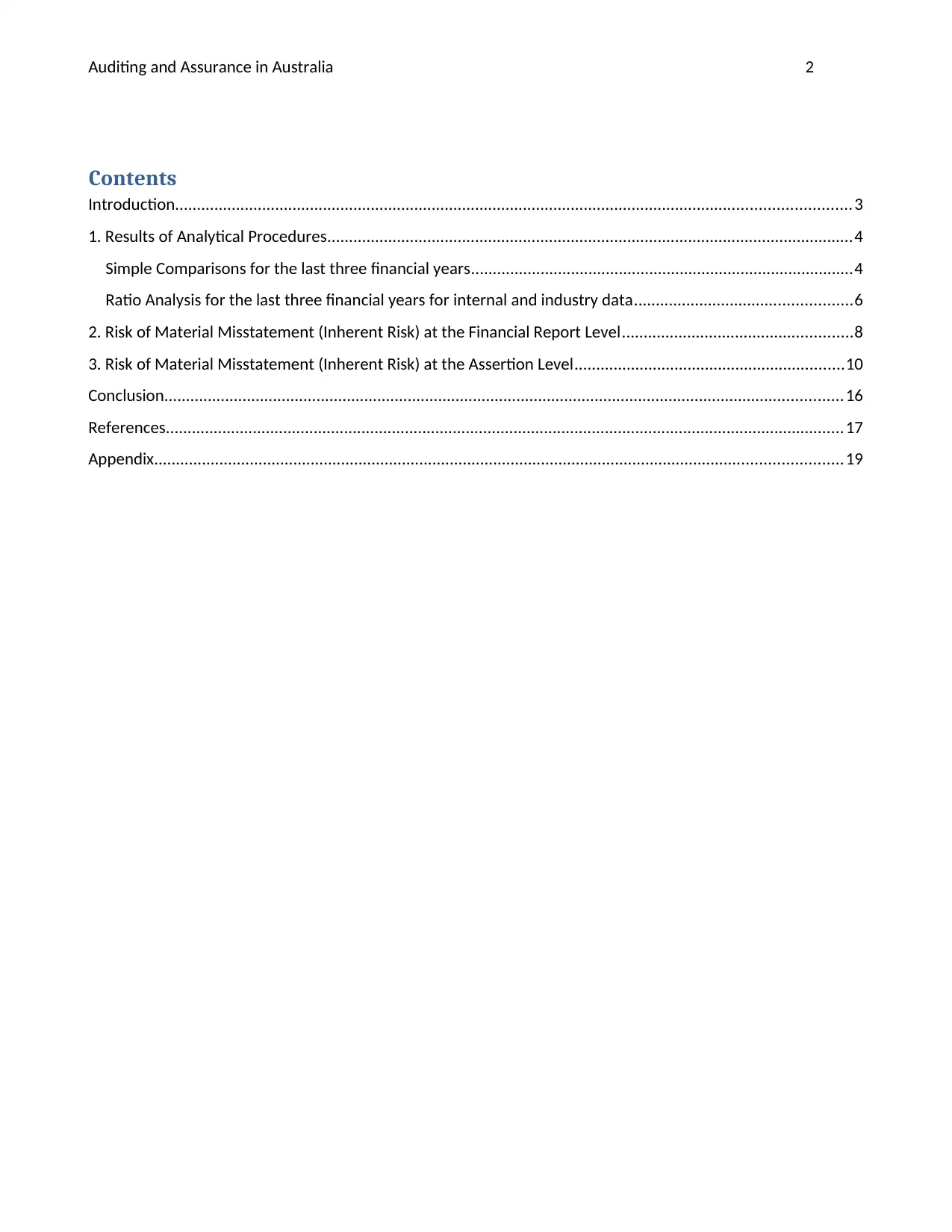
Auditing and Assurance in Australia 2
Contents
Introduction...........................................................................................................................................................3
1. Results of Analytical Procedures.........................................................................................................................4
Simple Comparisons for the last three financial years........................................................................................4
Ratio Analysis for the last three financial years for internal and industry data..................................................6
2. Risk of Material Misstatement (Inherent Risk) at the Financial Report Level.....................................................8
3. Risk of Material Misstatement (Inherent Risk) at the Assertion Level..............................................................10
Conclusion............................................................................................................................................................16
References............................................................................................................................................................17
Appendix..............................................................................................................................................................19
Contents
Introduction...........................................................................................................................................................3
1. Results of Analytical Procedures.........................................................................................................................4
Simple Comparisons for the last three financial years........................................................................................4
Ratio Analysis for the last three financial years for internal and industry data..................................................6
2. Risk of Material Misstatement (Inherent Risk) at the Financial Report Level.....................................................8
3. Risk of Material Misstatement (Inherent Risk) at the Assertion Level..............................................................10
Conclusion............................................................................................................................................................16
References............................................................................................................................................................17
Appendix..............................................................................................................................................................19
⊘ This is a preview!⊘
Do you want full access?
Subscribe today to unlock all pages.

Trusted by 1+ million students worldwide
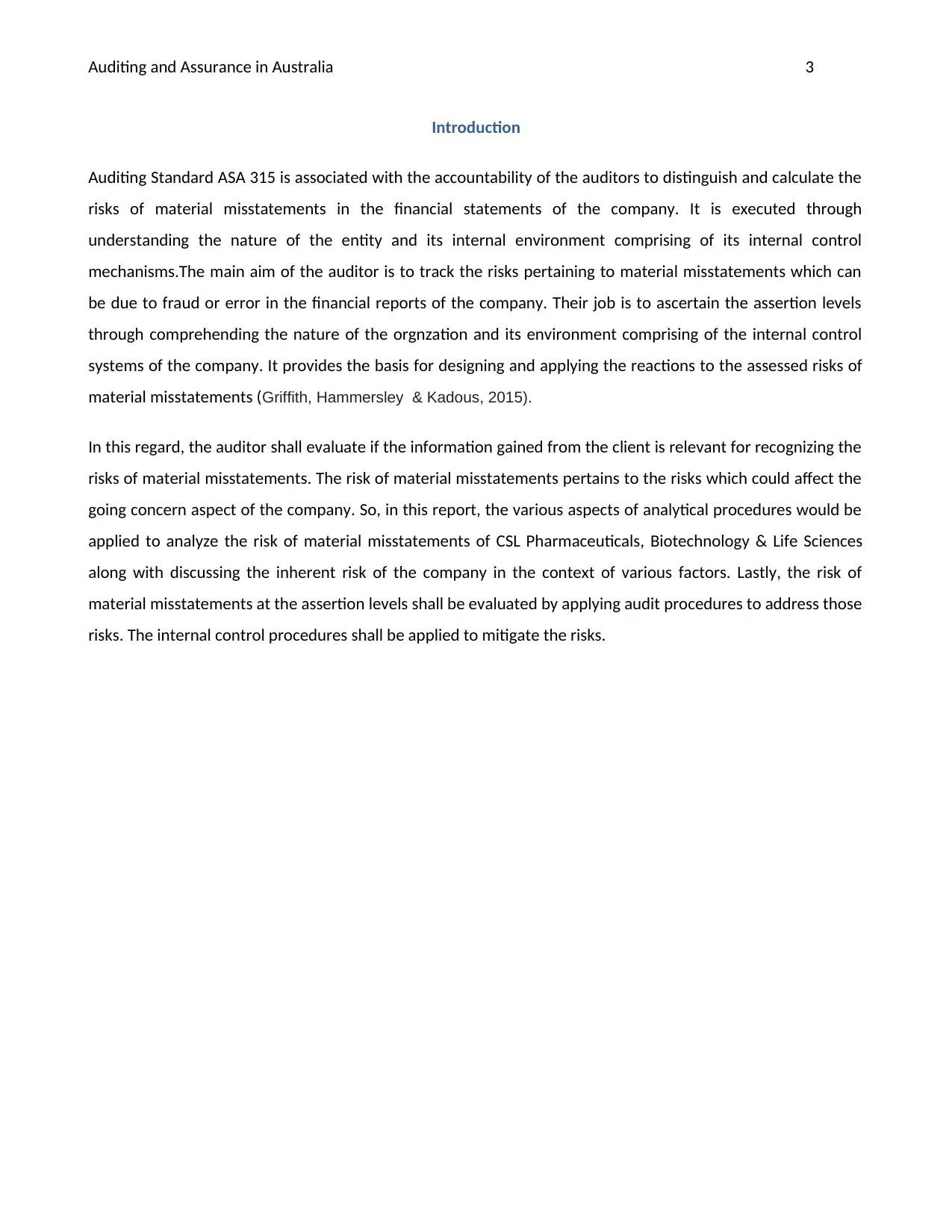
Auditing and Assurance in Australia 3
Introduction
Auditing Standard ASA 315 is associated with the accountability of the auditors to distinguish and calculate the
risks of material misstatements in the financial statements of the company. It is executed through
understanding the nature of the entity and its internal environment comprising of its internal control
mechanisms.The main aim of the auditor is to track the risks pertaining to material misstatements which can
be due to fraud or error in the financial reports of the company. Their job is to ascertain the assertion levels
through comprehending the nature of the orgnzation and its environment comprising of the internal control
systems of the company. It provides the basis for designing and applying the reactions to the assessed risks of
material misstatements (Griffith, Hammersley & Kadous, 2015).
In this regard, the auditor shall evaluate if the information gained from the client is relevant for recognizing the
risks of material misstatements. The risk of material misstatements pertains to the risks which could affect the
going concern aspect of the company. So, in this report, the various aspects of analytical procedures would be
applied to analyze the risk of material misstatements of CSL Pharmaceuticals, Biotechnology & Life Sciences
along with discussing the inherent risk of the company in the context of various factors. Lastly, the risk of
material misstatements at the assertion levels shall be evaluated by applying audit procedures to address those
risks. The internal control procedures shall be applied to mitigate the risks.
Introduction
Auditing Standard ASA 315 is associated with the accountability of the auditors to distinguish and calculate the
risks of material misstatements in the financial statements of the company. It is executed through
understanding the nature of the entity and its internal environment comprising of its internal control
mechanisms.The main aim of the auditor is to track the risks pertaining to material misstatements which can
be due to fraud or error in the financial reports of the company. Their job is to ascertain the assertion levels
through comprehending the nature of the orgnzation and its environment comprising of the internal control
systems of the company. It provides the basis for designing and applying the reactions to the assessed risks of
material misstatements (Griffith, Hammersley & Kadous, 2015).
In this regard, the auditor shall evaluate if the information gained from the client is relevant for recognizing the
risks of material misstatements. The risk of material misstatements pertains to the risks which could affect the
going concern aspect of the company. So, in this report, the various aspects of analytical procedures would be
applied to analyze the risk of material misstatements of CSL Pharmaceuticals, Biotechnology & Life Sciences
along with discussing the inherent risk of the company in the context of various factors. Lastly, the risk of
material misstatements at the assertion levels shall be evaluated by applying audit procedures to address those
risks. The internal control procedures shall be applied to mitigate the risks.
Paraphrase This Document
Need a fresh take? Get an instant paraphrase of this document with our AI Paraphraser
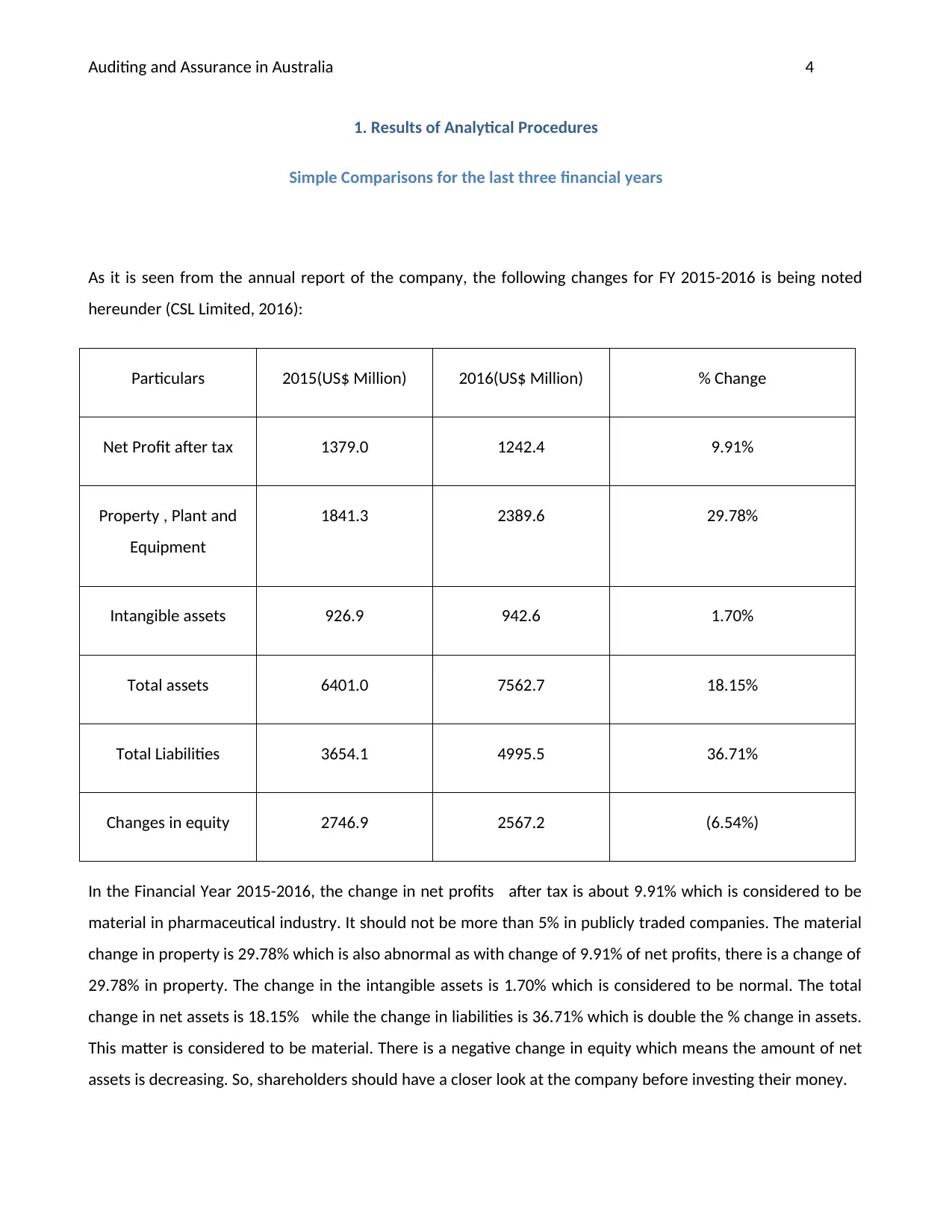
Auditing and Assurance in Australia 4
1. Results of Analytical Procedures
Simple Comparisons for the last three financial years
As it is seen from the annual report of the company, the following changes for FY 2015-2016 is being noted
hereunder (CSL Limited, 2016):
Particulars 2015(US$ Million) 2016(US$ Million) % Change
Net Profit after tax 1379.0 1242.4 9.91%
Property , Plant and
Equipment
1841.3 2389.6 29.78%
Intangible assets 926.9 942.6 1.70%
Total assets 6401.0 7562.7 18.15%
Total Liabilities 3654.1 4995.5 36.71%
Changes in equity 2746.9 2567.2 (6.54%)
In the Financial Year 2015-2016, the change in net profits after tax is about 9.91% which is considered to be
material in pharmaceutical industry. It should not be more than 5% in publicly traded companies. The material
change in property is 29.78% which is also abnormal as with change of 9.91% of net profits, there is a change of
29.78% in property. The change in the intangible assets is 1.70% which is considered to be normal. The total
change in net assets is 18.15% while the change in liabilities is 36.71% which is double the % change in assets.
This matter is considered to be material. There is a negative change in equity which means the amount of net
assets is decreasing. So, shareholders should have a closer look at the company before investing their money.
1. Results of Analytical Procedures
Simple Comparisons for the last three financial years
As it is seen from the annual report of the company, the following changes for FY 2015-2016 is being noted
hereunder (CSL Limited, 2016):
Particulars 2015(US$ Million) 2016(US$ Million) % Change
Net Profit after tax 1379.0 1242.4 9.91%
Property , Plant and
Equipment
1841.3 2389.6 29.78%
Intangible assets 926.9 942.6 1.70%
Total assets 6401.0 7562.7 18.15%
Total Liabilities 3654.1 4995.5 36.71%
Changes in equity 2746.9 2567.2 (6.54%)
In the Financial Year 2015-2016, the change in net profits after tax is about 9.91% which is considered to be
material in pharmaceutical industry. It should not be more than 5% in publicly traded companies. The material
change in property is 29.78% which is also abnormal as with change of 9.91% of net profits, there is a change of
29.78% in property. The change in the intangible assets is 1.70% which is considered to be normal. The total
change in net assets is 18.15% while the change in liabilities is 36.71% which is double the % change in assets.
This matter is considered to be material. There is a negative change in equity which means the amount of net
assets is decreasing. So, shareholders should have a closer look at the company before investing their money.
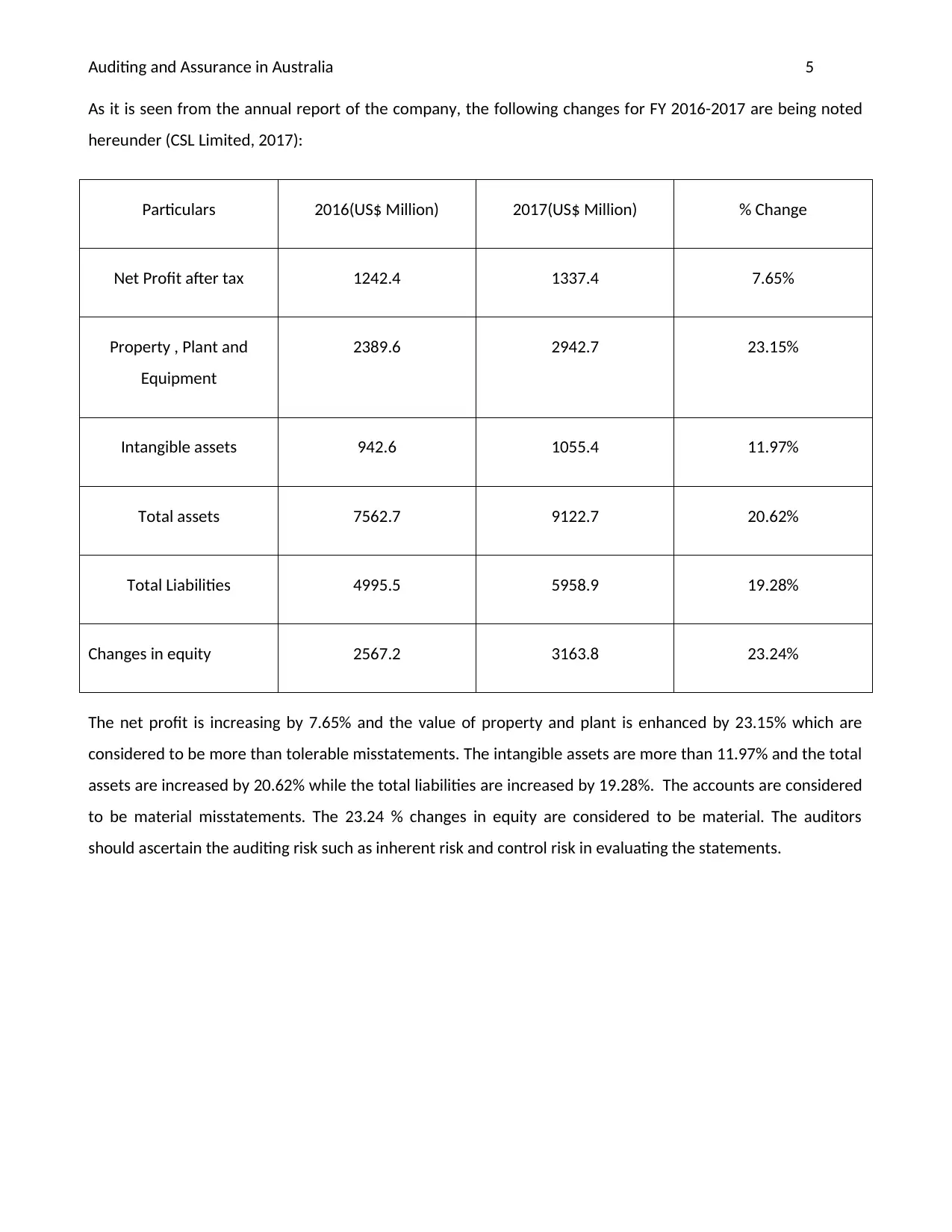
Auditing and Assurance in Australia 5
As it is seen from the annual report of the company, the following changes for FY 2016-2017 are being noted
hereunder (CSL Limited, 2017):
Particulars 2016(US$ Million) 2017(US$ Million) % Change
Net Profit after tax 1242.4 1337.4 7.65%
Property , Plant and
Equipment
2389.6 2942.7 23.15%
Intangible assets 942.6 1055.4 11.97%
Total assets 7562.7 9122.7 20.62%
Total Liabilities 4995.5 5958.9 19.28%
Changes in equity 2567.2 3163.8 23.24%
The net profit is increasing by 7.65% and the value of property and plant is enhanced by 23.15% which are
considered to be more than tolerable misstatements. The intangible assets are more than 11.97% and the total
assets are increased by 20.62% while the total liabilities are increased by 19.28%. The accounts are considered
to be material misstatements. The 23.24 % changes in equity are considered to be material. The auditors
should ascertain the auditing risk such as inherent risk and control risk in evaluating the statements.
As it is seen from the annual report of the company, the following changes for FY 2016-2017 are being noted
hereunder (CSL Limited, 2017):
Particulars 2016(US$ Million) 2017(US$ Million) % Change
Net Profit after tax 1242.4 1337.4 7.65%
Property , Plant and
Equipment
2389.6 2942.7 23.15%
Intangible assets 942.6 1055.4 11.97%
Total assets 7562.7 9122.7 20.62%
Total Liabilities 4995.5 5958.9 19.28%
Changes in equity 2567.2 3163.8 23.24%
The net profit is increasing by 7.65% and the value of property and plant is enhanced by 23.15% which are
considered to be more than tolerable misstatements. The intangible assets are more than 11.97% and the total
assets are increased by 20.62% while the total liabilities are increased by 19.28%. The accounts are considered
to be material misstatements. The 23.24 % changes in equity are considered to be material. The auditors
should ascertain the auditing risk such as inherent risk and control risk in evaluating the statements.
⊘ This is a preview!⊘
Do you want full access?
Subscribe today to unlock all pages.

Trusted by 1+ million students worldwide
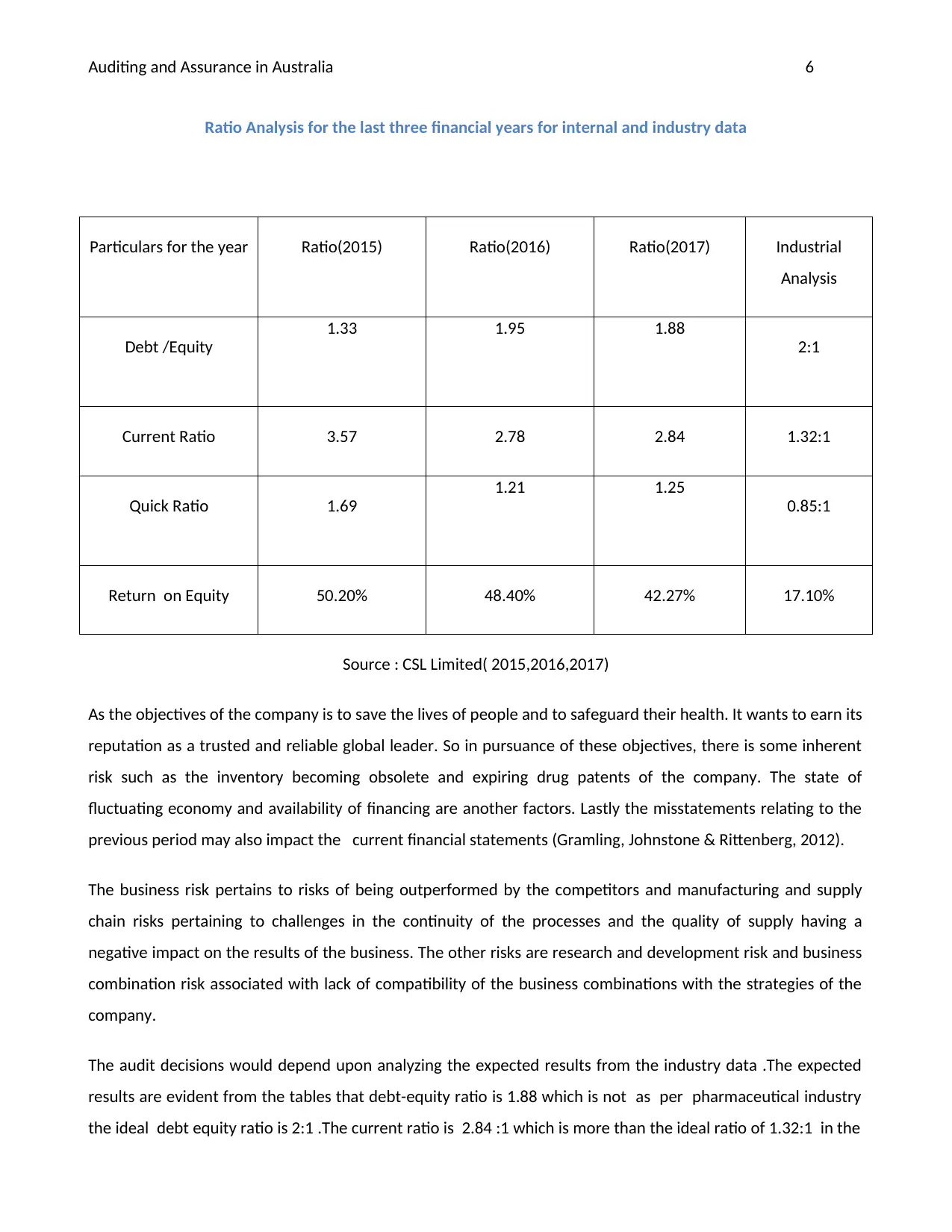
Auditing and Assurance in Australia 6
Ratio Analysis for the last three financial years for internal and industry data
Particulars for the year Ratio(2015) Ratio(2016) Ratio(2017) Industrial
Analysis
Debt /Equity
1.33 1.95 1.88
2:1
Current Ratio 3.57 2.78 2.84 1.32:1
Quick Ratio 1.69
1.21 1.25
0.85:1
Return on Equity 50.20% 48.40% 42.27% 17.10%
Source : CSL Limited( 2015,2016,2017)
As the objectives of the company is to save the lives of people and to safeguard their health. It wants to earn its
reputation as a trusted and reliable global leader. So in pursuance of these objectives, there is some inherent
risk such as the inventory becoming obsolete and expiring drug patents of the company. The state of
fluctuating economy and availability of financing are another factors. Lastly the misstatements relating to the
previous period may also impact the current financial statements (Gramling, Johnstone & Rittenberg, 2012).
The business risk pertains to risks of being outperformed by the competitors and manufacturing and supply
chain risks pertaining to challenges in the continuity of the processes and the quality of supply having a
negative impact on the results of the business. The other risks are research and development risk and business
combination risk associated with lack of compatibility of the business combinations with the strategies of the
company.
The audit decisions would depend upon analyzing the expected results from the industry data .The expected
results are evident from the tables that debt-equity ratio is 1.88 which is not as per pharmaceutical industry
the ideal debt equity ratio is 2:1 .The current ratio is 2.84 :1 which is more than the ideal ratio of 1.32:1 in the
Ratio Analysis for the last three financial years for internal and industry data
Particulars for the year Ratio(2015) Ratio(2016) Ratio(2017) Industrial
Analysis
Debt /Equity
1.33 1.95 1.88
2:1
Current Ratio 3.57 2.78 2.84 1.32:1
Quick Ratio 1.69
1.21 1.25
0.85:1
Return on Equity 50.20% 48.40% 42.27% 17.10%
Source : CSL Limited( 2015,2016,2017)
As the objectives of the company is to save the lives of people and to safeguard their health. It wants to earn its
reputation as a trusted and reliable global leader. So in pursuance of these objectives, there is some inherent
risk such as the inventory becoming obsolete and expiring drug patents of the company. The state of
fluctuating economy and availability of financing are another factors. Lastly the misstatements relating to the
previous period may also impact the current financial statements (Gramling, Johnstone & Rittenberg, 2012).
The business risk pertains to risks of being outperformed by the competitors and manufacturing and supply
chain risks pertaining to challenges in the continuity of the processes and the quality of supply having a
negative impact on the results of the business. The other risks are research and development risk and business
combination risk associated with lack of compatibility of the business combinations with the strategies of the
company.
The audit decisions would depend upon analyzing the expected results from the industry data .The expected
results are evident from the tables that debt-equity ratio is 1.88 which is not as per pharmaceutical industry
the ideal debt equity ratio is 2:1 .The current ratio is 2.84 :1 which is more than the ideal ratio of 1.32:1 in the
Paraphrase This Document
Need a fresh take? Get an instant paraphrase of this document with our AI Paraphraser
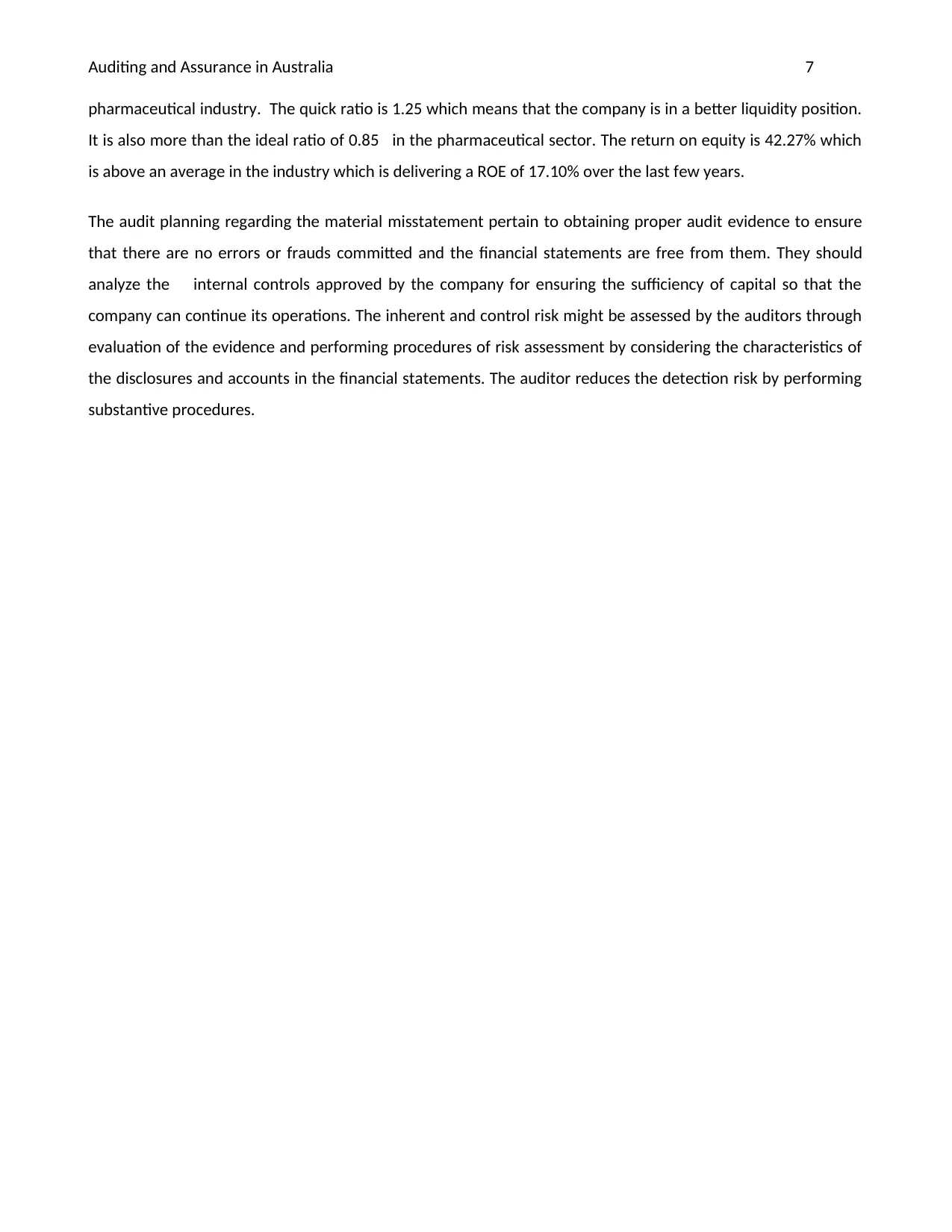
Auditing and Assurance in Australia 7
pharmaceutical industry. The quick ratio is 1.25 which means that the company is in a better liquidity position.
It is also more than the ideal ratio of 0.85 in the pharmaceutical sector. The return on equity is 42.27% which
is above an average in the industry which is delivering a ROE of 17.10% over the last few years.
The audit planning regarding the material misstatement pertain to obtaining proper audit evidence to ensure
that there are no errors or frauds committed and the financial statements are free from them. They should
analyze the internal controls approved by the company for ensuring the sufficiency of capital so that the
company can continue its operations. The inherent and control risk might be assessed by the auditors through
evaluation of the evidence and performing procedures of risk assessment by considering the characteristics of
the disclosures and accounts in the financial statements. The auditor reduces the detection risk by performing
substantive procedures.
pharmaceutical industry. The quick ratio is 1.25 which means that the company is in a better liquidity position.
It is also more than the ideal ratio of 0.85 in the pharmaceutical sector. The return on equity is 42.27% which
is above an average in the industry which is delivering a ROE of 17.10% over the last few years.
The audit planning regarding the material misstatement pertain to obtaining proper audit evidence to ensure
that there are no errors or frauds committed and the financial statements are free from them. They should
analyze the internal controls approved by the company for ensuring the sufficiency of capital so that the
company can continue its operations. The inherent and control risk might be assessed by the auditors through
evaluation of the evidence and performing procedures of risk assessment by considering the characteristics of
the disclosures and accounts in the financial statements. The auditor reduces the detection risk by performing
substantive procedures.
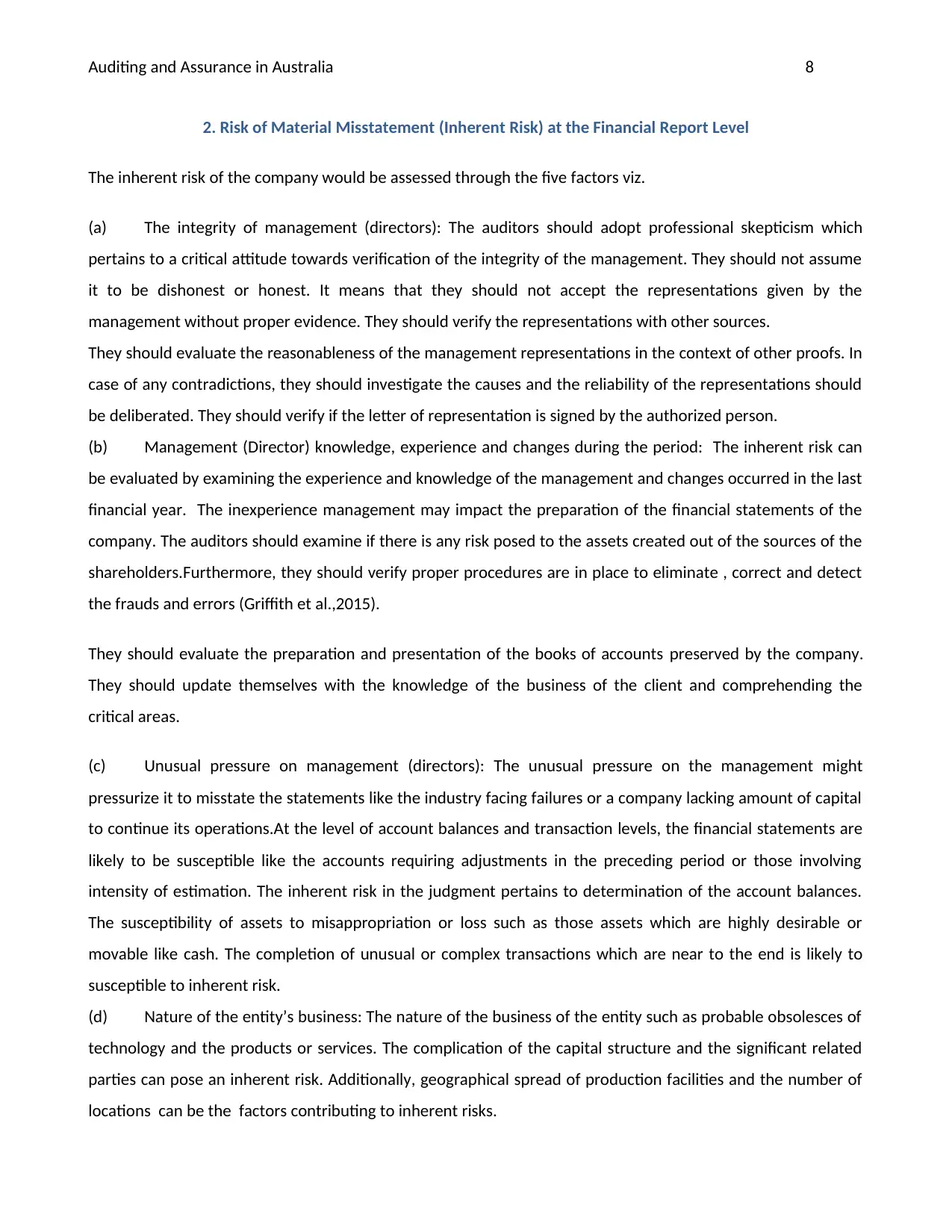
Auditing and Assurance in Australia 8
2. Risk of Material Misstatement (Inherent Risk) at the Financial Report Level
The inherent risk of the company would be assessed through the five factors viz.
(a) The integrity of management (directors): The auditors should adopt professional skepticism which
pertains to a critical attitude towards verification of the integrity of the management. They should not assume
it to be dishonest or honest. It means that they should not accept the representations given by the
management without proper evidence. They should verify the representations with other sources.
They should evaluate the reasonableness of the management representations in the context of other proofs. In
case of any contradictions, they should investigate the causes and the reliability of the representations should
be deliberated. They should verify if the letter of representation is signed by the authorized person.
(b) Management (Director) knowledge, experience and changes during the period: The inherent risk can
be evaluated by examining the experience and knowledge of the management and changes occurred in the last
financial year. The inexperience management may impact the preparation of the financial statements of the
company. The auditors should examine if there is any risk posed to the assets created out of the sources of the
shareholders.Furthermore, they should verify proper procedures are in place to eliminate , correct and detect
the frauds and errors (Griffith et al.,2015).
They should evaluate the preparation and presentation of the books of accounts preserved by the company.
They should update themselves with the knowledge of the business of the client and comprehending the
critical areas.
(c) Unusual pressure on management (directors): The unusual pressure on the management might
pressurize it to misstate the statements like the industry facing failures or a company lacking amount of capital
to continue its operations.At the level of account balances and transaction levels, the financial statements are
likely to be susceptible like the accounts requiring adjustments in the preceding period or those involving
intensity of estimation. The inherent risk in the judgment pertains to determination of the account balances.
The susceptibility of assets to misappropriation or loss such as those assets which are highly desirable or
movable like cash. The completion of unusual or complex transactions which are near to the end is likely to
susceptible to inherent risk.
(d) Nature of the entity’s business: The nature of the business of the entity such as probable obsolesces of
technology and the products or services. The complication of the capital structure and the significant related
parties can pose an inherent risk. Additionally, geographical spread of production facilities and the number of
locations can be the factors contributing to inherent risks.
2. Risk of Material Misstatement (Inherent Risk) at the Financial Report Level
The inherent risk of the company would be assessed through the five factors viz.
(a) The integrity of management (directors): The auditors should adopt professional skepticism which
pertains to a critical attitude towards verification of the integrity of the management. They should not assume
it to be dishonest or honest. It means that they should not accept the representations given by the
management without proper evidence. They should verify the representations with other sources.
They should evaluate the reasonableness of the management representations in the context of other proofs. In
case of any contradictions, they should investigate the causes and the reliability of the representations should
be deliberated. They should verify if the letter of representation is signed by the authorized person.
(b) Management (Director) knowledge, experience and changes during the period: The inherent risk can
be evaluated by examining the experience and knowledge of the management and changes occurred in the last
financial year. The inexperience management may impact the preparation of the financial statements of the
company. The auditors should examine if there is any risk posed to the assets created out of the sources of the
shareholders.Furthermore, they should verify proper procedures are in place to eliminate , correct and detect
the frauds and errors (Griffith et al.,2015).
They should evaluate the preparation and presentation of the books of accounts preserved by the company.
They should update themselves with the knowledge of the business of the client and comprehending the
critical areas.
(c) Unusual pressure on management (directors): The unusual pressure on the management might
pressurize it to misstate the statements like the industry facing failures or a company lacking amount of capital
to continue its operations.At the level of account balances and transaction levels, the financial statements are
likely to be susceptible like the accounts requiring adjustments in the preceding period or those involving
intensity of estimation. The inherent risk in the judgment pertains to determination of the account balances.
The susceptibility of assets to misappropriation or loss such as those assets which are highly desirable or
movable like cash. The completion of unusual or complex transactions which are near to the end is likely to
susceptible to inherent risk.
(d) Nature of the entity’s business: The nature of the business of the entity such as probable obsolesces of
technology and the products or services. The complication of the capital structure and the significant related
parties can pose an inherent risk. Additionally, geographical spread of production facilities and the number of
locations can be the factors contributing to inherent risks.
⊘ This is a preview!⊘
Do you want full access?
Subscribe today to unlock all pages.

Trusted by 1+ million students worldwide
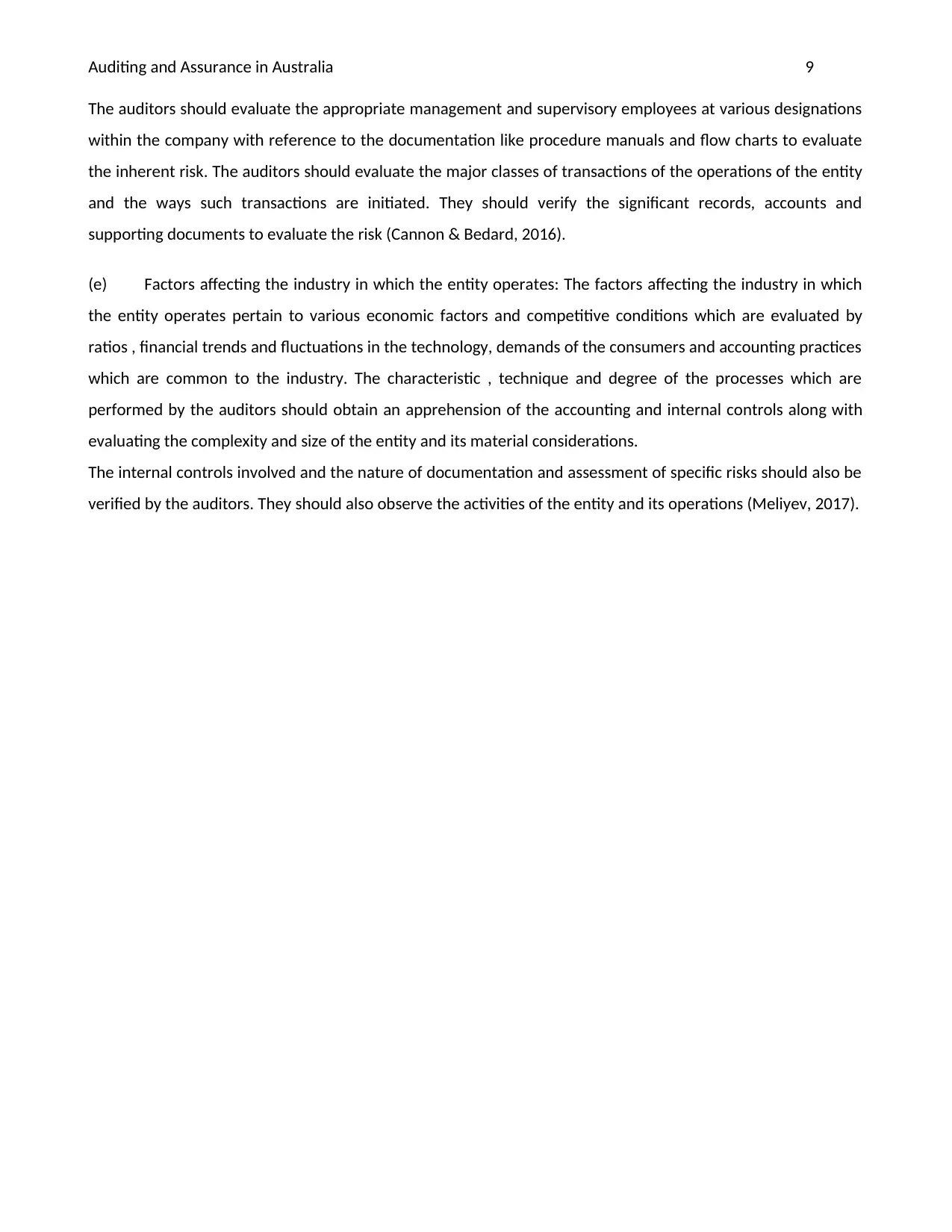
Auditing and Assurance in Australia 9
The auditors should evaluate the appropriate management and supervisory employees at various designations
within the company with reference to the documentation like procedure manuals and flow charts to evaluate
the inherent risk. The auditors should evaluate the major classes of transactions of the operations of the entity
and the ways such transactions are initiated. They should verify the significant records, accounts and
supporting documents to evaluate the risk (Cannon & Bedard, 2016).
(e) Factors affecting the industry in which the entity operates: The factors affecting the industry in which
the entity operates pertain to various economic factors and competitive conditions which are evaluated by
ratios , financial trends and fluctuations in the technology, demands of the consumers and accounting practices
which are common to the industry. The characteristic , technique and degree of the processes which are
performed by the auditors should obtain an apprehension of the accounting and internal controls along with
evaluating the complexity and size of the entity and its material considerations.
The internal controls involved and the nature of documentation and assessment of specific risks should also be
verified by the auditors. They should also observe the activities of the entity and its operations (Meliyev, 2017).
The auditors should evaluate the appropriate management and supervisory employees at various designations
within the company with reference to the documentation like procedure manuals and flow charts to evaluate
the inherent risk. The auditors should evaluate the major classes of transactions of the operations of the entity
and the ways such transactions are initiated. They should verify the significant records, accounts and
supporting documents to evaluate the risk (Cannon & Bedard, 2016).
(e) Factors affecting the industry in which the entity operates: The factors affecting the industry in which
the entity operates pertain to various economic factors and competitive conditions which are evaluated by
ratios , financial trends and fluctuations in the technology, demands of the consumers and accounting practices
which are common to the industry. The characteristic , technique and degree of the processes which are
performed by the auditors should obtain an apprehension of the accounting and internal controls along with
evaluating the complexity and size of the entity and its material considerations.
The internal controls involved and the nature of documentation and assessment of specific risks should also be
verified by the auditors. They should also observe the activities of the entity and its operations (Meliyev, 2017).
Paraphrase This Document
Need a fresh take? Get an instant paraphrase of this document with our AI Paraphraser
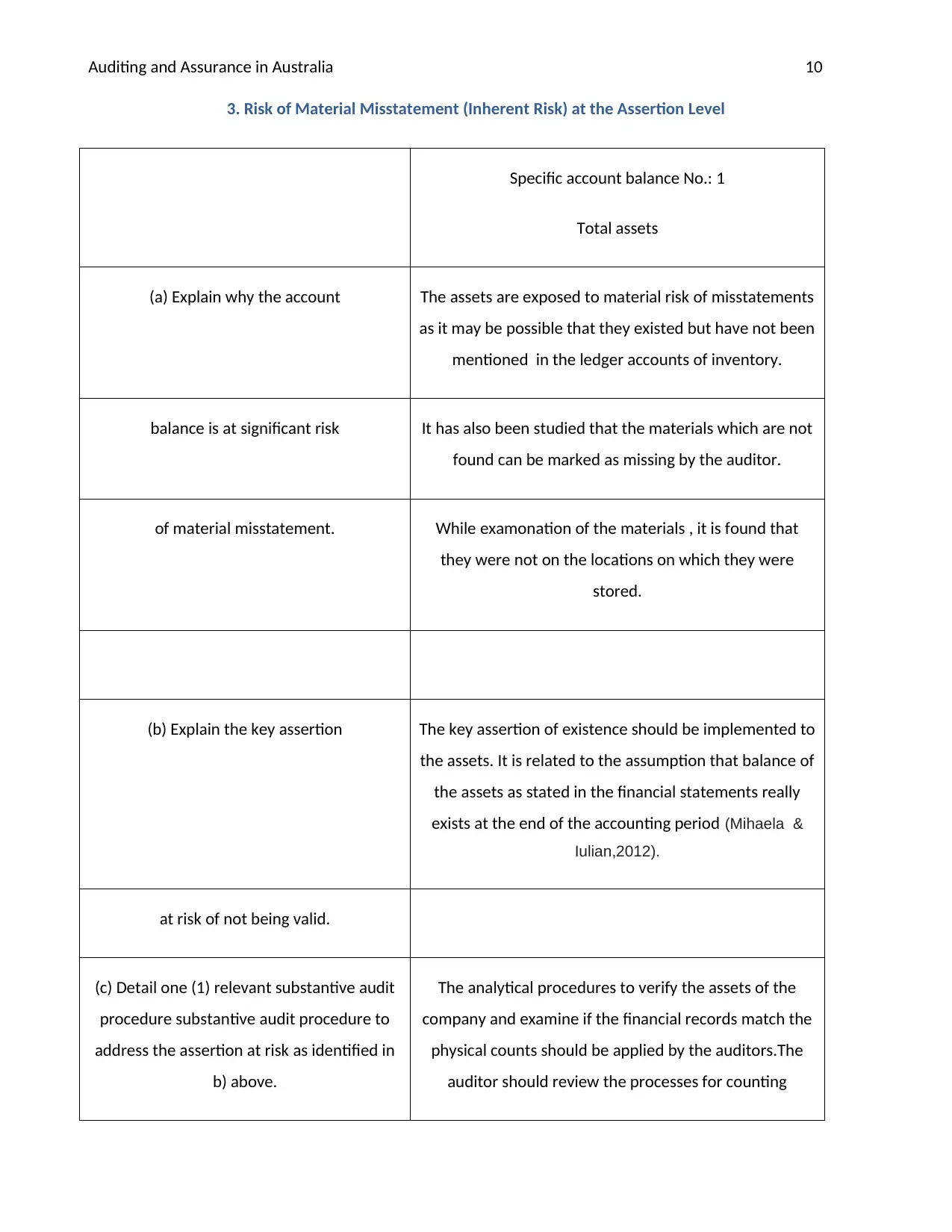
Auditing and Assurance in Australia 10
3. Risk of Material Misstatement (Inherent Risk) at the Assertion Level
Specific account balance No.: 1
Total assets
(a) Explain why the account The assets are exposed to material risk of misstatements
as it may be possible that they existed but have not been
mentioned in the ledger accounts of inventory.
balance is at significant risk It has also been studied that the materials which are not
found can be marked as missing by the auditor.
of material misstatement. While examonation of the materials , it is found that
they were not on the locations on which they were
stored.
(b) Explain the key assertion The key assertion of existence should be implemented to
the assets. It is related to the assumption that balance of
the assets as stated in the financial statements really
exists at the end of the accounting period (Mihaela &
Iulian,2012).
at risk of not being valid.
(c) Detail one (1) relevant substantive audit
procedure substantive audit procedure to
address the assertion at risk as identified in
b) above.
The analytical procedures to verify the assets of the
company and examine if the financial records match the
physical counts should be applied by the auditors.The
auditor should review the processes for counting
3. Risk of Material Misstatement (Inherent Risk) at the Assertion Level
Specific account balance No.: 1
Total assets
(a) Explain why the account The assets are exposed to material risk of misstatements
as it may be possible that they existed but have not been
mentioned in the ledger accounts of inventory.
balance is at significant risk It has also been studied that the materials which are not
found can be marked as missing by the auditor.
of material misstatement. While examonation of the materials , it is found that
they were not on the locations on which they were
stored.
(b) Explain the key assertion The key assertion of existence should be implemented to
the assets. It is related to the assumption that balance of
the assets as stated in the financial statements really
exists at the end of the accounting period (Mihaela &
Iulian,2012).
at risk of not being valid.
(c) Detail one (1) relevant substantive audit
procedure substantive audit procedure to
address the assertion at risk as identified in
b) above.
The analytical procedures to verify the assets of the
company and examine if the financial records match the
physical counts should be applied by the auditors.The
auditor should review the processes for counting
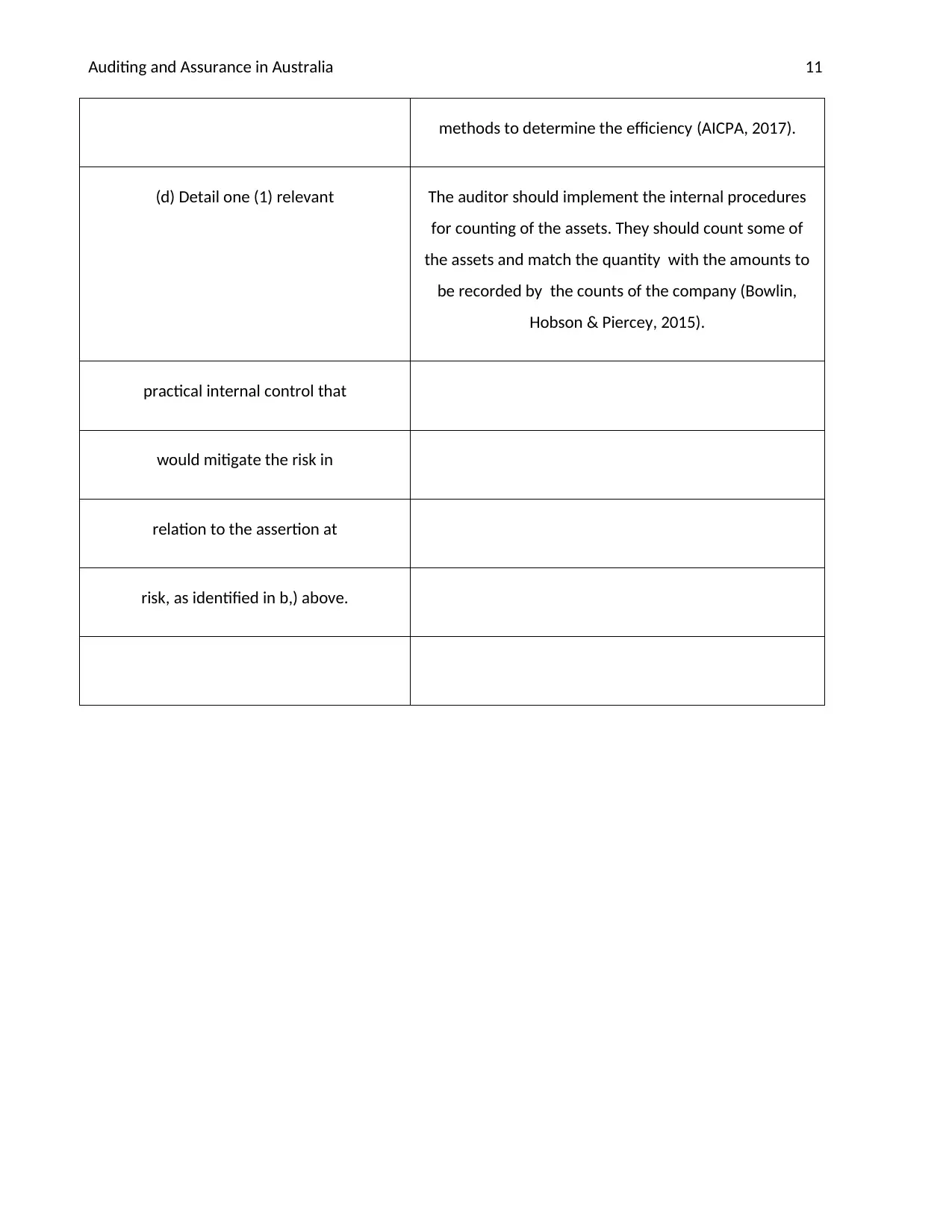
Auditing and Assurance in Australia 11
methods to determine the efficiency (AICPA, 2017).
(d) Detail one (1) relevant The auditor should implement the internal procedures
for counting of the assets. They should count some of
the assets and match the quantity with the amounts to
be recorded by the counts of the company (Bowlin,
Hobson & Piercey, 2015).
practical internal control that
would mitigate the risk in
relation to the assertion at
risk, as identified in b,) above.
methods to determine the efficiency (AICPA, 2017).
(d) Detail one (1) relevant The auditor should implement the internal procedures
for counting of the assets. They should count some of
the assets and match the quantity with the amounts to
be recorded by the counts of the company (Bowlin,
Hobson & Piercey, 2015).
practical internal control that
would mitigate the risk in
relation to the assertion at
risk, as identified in b,) above.
⊘ This is a preview!⊘
Do you want full access?
Subscribe today to unlock all pages.

Trusted by 1+ million students worldwide
1 out of 20
Related Documents
Your All-in-One AI-Powered Toolkit for Academic Success.
+13062052269
info@desklib.com
Available 24*7 on WhatsApp / Email
![[object Object]](/_next/static/media/star-bottom.7253800d.svg)
Unlock your academic potential
Copyright © 2020–2025 A2Z Services. All Rights Reserved. Developed and managed by ZUCOL.





